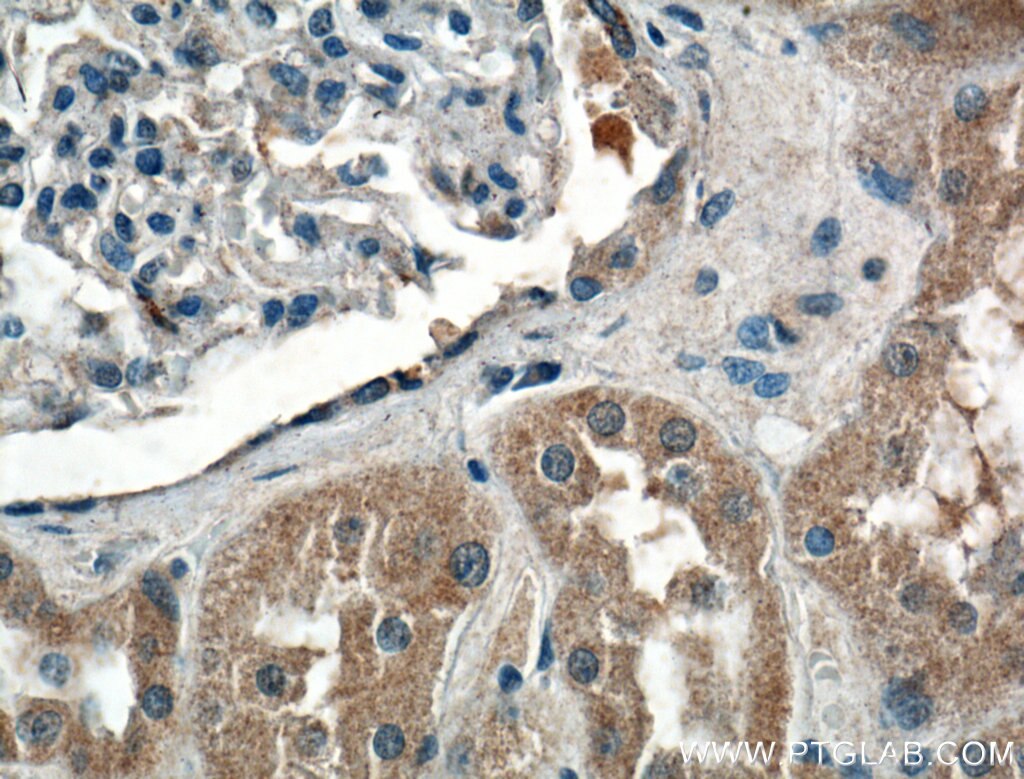Tested Applications
| Positive IHC detected in | human kidney tissue Note: suggested antigen retrieval with TE buffer pH 9.0; (*) Alternatively, antigen retrieval may be performed with citrate buffer pH 6.0 |
Recommended dilution
| Application | Dilution |
|---|---|
| Immunohistochemistry (IHC) | IHC : 1:50-1:500 |
| It is recommended that this reagent should be titrated in each testing system to obtain optimal results. | |
| Sample-dependent, Check data in validation data gallery. | |
Product Information
24449-1-AP targets CCBE1 in IHC, ELISA applications and shows reactivity with human samples.
| Tested Reactivity | human |
| Host / Isotype | Rabbit / IgG |
| Class | Polyclonal |
| Type | Antibody |
| Immunogen |
CatNo: Ag19686 Product name: Recombinant human CCBE1 protein Source: e coli.-derived, PET28a Tag: 6*His Domain: 1-215 aa of BC046645 Sequence: MVKAGTCCATCKEFYQMKQTVLQLKQKIALLPNNAADLGKYITGDKVLASNTYLPGPPGLPGGQGPPGSPGPKGSPGFPGMPGPPGQPGPRGSMGPMGPSPDLSHIKQGRRGPVGPPGAPGRDGSKGERGAPGPRGSPGPPGSFDFLLLMLADIRNDITELQEKVFGHRTHSSAEEFPLPQEFPSYPEAMDLGSGDDHPRRTETRDLRAPRDFYP Predict reactive species |
| Full Name | collagen and calcium binding EGF domains 1 |
| Calculated Molecular Weight | 406 aa, 44 kDa |
| GenBank Accession Number | BC046645 |
| Gene Symbol | CCBE1 |
| Gene ID (NCBI) | 147372 |
| RRID | AB_2879553 |
| Conjugate | Unconjugated |
| Form | Liquid |
| Purification Method | Antigen affinity purification |
| UNIPROT ID | Q6UXH8 |
| Storage Buffer | PBS with 0.02% sodium azide and 50% glycerol, pH 7.3. |
| Storage Conditions | Store at -20°C. Stable for one year after shipment. Aliquoting is unnecessary for -20oC storage. 20ul sizes contain 0.1% BSA. |
Background Information
CCBE1 (collagen and calcium-binding EGF domain-containing protein 1) is a secreted protein that is indispensible for lymphangiogenesis during development. CCBE1 may be a guidance molecule that regulates lymphangioblast budding and possibly migration (PMID: 19287381). The gene of CCBE1 maps to 18q21.32 and encodes a protein of 44 kDa that contains an EGF-like domain and two collagen-like domains. Mutations in the CCBE1 gene cause Hennekam lymphangiectasia-lymphedema syndrome (PMID: 19935664).
Protocols
| Product Specific Protocols | |
|---|---|
| IHC protocol for CCBE1 antibody 24449-1-AP | Download protocol |
| Standard Protocols | |
|---|---|
| Click here to view our Standard Protocols |






